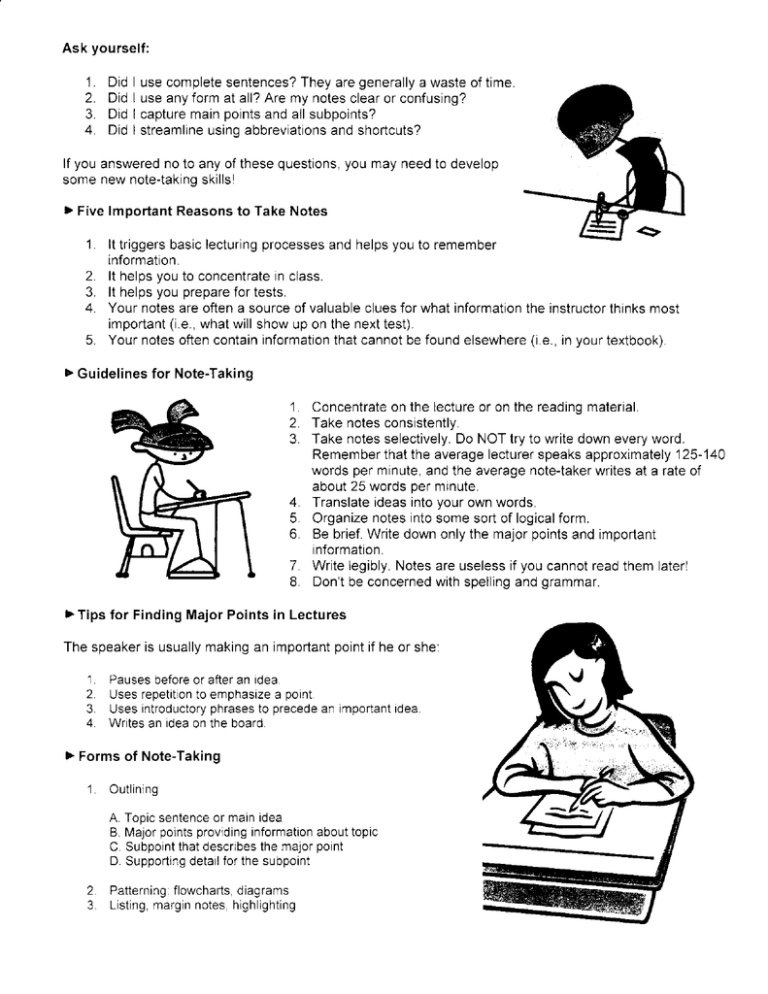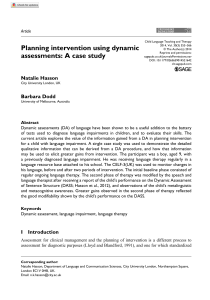
Ask yourself:
1. Did I use complete sentences? They are generally a waste of time.
2. Did I use any form at all? Are my notes clear or confusing?
3. Did I capture main points and all subpoints?
4. Did lstreamline using abbreviations and shortcuts?
lf you answered no to any of these questions, you may need to develop
some new note{aking skills
I
> Five lmportant Reasons to Take Notes
'1
.
2.
3.
4.
5.
lt triggers basic lecturing processes and helps you to remember
information.
lt helps you to concentrate in class.
lt helps you prepare for tests.
Your notes are often a source of valuable clues for what information the instructor thinks most
important (i.e.. what will show up on the next test).
Your notes often contain information that cannot be found elsewhere (i.e., in your textbook)
> Guidelines for Note-Takinq
Concentrate on the lecture or on the reading material.
2. Take notes consistently.
3 Take notes selectively. Do NOT try to write down every word.
Remember that the average lecturer speaks approximately 125-140
words per minute, and the average note{aker writes at a rate of
about 25 words per minute.
A
Translate ideas into your own words.
5 Organize notes into some sort of logical form.
6. Be brief. Write down only the major points and important
information.
7. Write legibly. Notes are useless if you cannot read them laterl
8 Don't be concerned with spelling and grammar.
1
> Tips for Finding Major Points in Lectures
The speaker is usually making an important point if he or she:
1.
2
3.
4.
)
Pauses before or after an idea
Uses 'epetit on to erphasize a point
Uses introductory phrases to precede an lmportant idea.
Writes an idea on the board.
Forms of Note-Taking
1.
O utlin
lng
A. Topic sentence or main idea
B. Major points provlding information about topic
C. Subpoint that describes the major point
D. Supporting detail for the subpoint
2
3
Patterning: flowcharts, diagrams
Listing, margin notes highlighting
Wavs to Reduce and Streamline Notes
1.
Eliminate small connecting words such as: is, are, was, were, a, an, the, would, this, of. Eliminate
pronouns such as: they, these, his. that, them. However, be careful NOT to elimate these three
words: and, in, on.
2.
Use symbols to abbreviate, such as:
+, & for and, plus
= for equals
- for minus
# for number
x for times
> for greater than, more, larger
< for less than. smaller. fewer than
w/ for with
w/o for without
w/in for within
----> for leads to, produces, results in
<---- for comes from
I for per
For example.
"The diameter of the Earth is four times greater than the diameter of the Moon."
Becomes:
"Earth = 4x > diameter of Moon."
3
Substitute numerals with symbols, for instance:
Substitute "one" with 1
Substitute "th ird" with 3rd
/l
Abbreviate:
Drop the last several letters of a word. For example, substitute "appropriate" with "approp
Drop some of the internal vowels of a word. For example, substitute "large" with "lrg."
-;12
'y'2-
Acrrvrry Snrpr
Name:
1-12
NorEr.nai<iNc
GuTDELTNES
Mapping
Mapping is a good visual way to organize inJormation and ideas. Read the passage that you
want to take notes
on' Then, {il1d the main idea and write it in the centre of your page and draw a circle arolnd
that idea. Write the
supporting ideas on Lines that branch out from the circled main idea. lnclude any sub-details
by connecting
them to the appropdate supporting idea. A short piece of text may only have one rnain
idea and a lew supporting ideas, while longer pieces will need more main ideas and supporting points to
be included. A1l points should
be carefully numbered and lettered. A map can be drawn in any way that makes
sense to you, the notemaker.
Main Idea or Point
'".
*
Outline
An outline is similar to mapping, but it uses a chart Iorm, rather than a map. List the main idea
on the first
line and then fill in the supporting ideas and sub-details on the subsequent llst.
Main idea
Supporting Idea
sub.detail
sub-detail
Supporting Idea
sub-detail
sub-detail
Pr€cis
Writing
Read the entire passage before rnaking notes.
Write in full sentences.
The.length should be approximately one third of the original text.
Maintain the same order as the original text.
You are allowed to use wording from the text as well as your own words.
7A
o
Prennce Flrll
cin3dr. rLl RIcHTS RlsERv!D ajtir"nslrr: irrurs drd,4.rj..
pcrmissLon ro phur!copy res(r.ted
to pulctrrriqq rclools
Name;
TIrs roR Nolliviazut';c
Notes can be taken from a variety of sources including: books, Internet, Iectures, speeches, presentations,
and fiims. As a notemaker, you are a readel listener, and observer'
Remember:
Don,t write down everything. lnstead, write in point form and look for main ideas and supporti.ng
evidence. However, be sure you have written enough so that your notes will make sense to you even weeks
later,
Be brief .
Use short forms such as standard abbreviations, symbois, and your own shorthand'
Leave a
little
space between ideas so that you can
jot down points and other information
as needed-
Write notes in your own words. This will help you ensure that you understand what you are learning.
Be accurate and record names, dates, places, and numbers correctly.
Preview what you are Soing to read and ask yourself questions as you read.
Look for key words and terms.
Listen lor cues that suggest that a main idea is coming. For example, "as a result" means cause or effect,
"second" signals a sequence, and "in conclusion" means a summary.
personal
Jot down thoughts that come to mind as you are taking notes ie.g., questions, sensory details, and
observations or ideas).
O ptcniice
tl,il
C.tr1dl, Al,I- RIGHTS RESERvED
Cj.i:g,rlioj Is3!.5 ,,d Ac.1o,. Pcrmtrion
ro lhorocoPy
r.sdict.d
to purcbasing
school3
69
ROBLEMS IN
Norg:TaxlNc'@
Lecture:
SPeaker
Well-organized
1.
2.
Talks too fast; sPeaks in
a monotone or has a sPeech
Notes
and will be
1. Notes are easY to take
well-organized.
and
2. Try to adjust Your ears
quicklY; be a good listener'
mind
problem.
3.
The sPeaker is boring'
3.
Force yourself to become an "active
next'
Iistener." Guess what's corning
the
make connecting Points with
presented, and think of ques-
material
tions to ask'
4.
6.
Uses difficult vocabularY
4.
i
cover
Read the text the speaker will
the
b"for. the lecture' Wait until after
lecture to look up difficult words'
I-eafs tfuough the text
while sPeaking'
5.
at hand'
Be sure to have your text close
Identify or note imPortant paragraphs'
The sPeakei rambies'
O.
W.it" something about
Dgresses to relate Personal
tes
experiences an d examP
the sPeaker'
8. You do not l-ike
tioned. Listen for inrroductory
concludhg statements'
7.
ald
to any lmRest your mind, but be alert
main ideas or details'
Portant
waste time or enerS:y thinking
spealer'
about why you do not like the
get on
You need the information' so
8.
- Don't
with note"taking!
+
O-1 6 € n ,.g-w PdE&a l-- rsri!' :x'
each topic men-
fnoslEMs IN NoTE-TIKtNG
AND How To Sorw Tffitvl
.
continud
Reading/Text:
Solution
'
Froblem
1. The text is boring'
2- Your mind wanders'
3.
diIficuit'
The vocabulary is
u:riis'
the inJormation ir'to sma-l]
Break
1.
'
R;; an entire unit and then go back
of completing-.
*a ,"1. notes' S€t a goalreward
Yourselfl
il;; ""io ""a thln
sheet
a check or "a( on a separate
Make
2.
that your
li o"*t each dme you realize
goal to r"rake
i-titltJ**aering set aassignment'
f"*", tl. marks for each
3
rry,to
without stoPPlng
Tii*:":tl,:
#:.T:[;
u
",
5E
eJter reading' loof uP
words and write the definitions'
^J
lili."f,"t$irtJ'
4.
There's too rnuch matenal'
and not enough time'
Divide the maiertar
4. Form a sildy group'
i" u. cov"r"d and assign trytJi:-l:9:;
'
memb€r' AsK EdLrl
chapters, etc', to each
and
,o take thorough notes
Then retun
studY the informadon'
and orallv share the
nr.il*t
io tn. gro"P
as-srgned material' Give Pnotoevery
copies of a-ll notes to
grouP
You stiil don't u-nderstand
the material alter reading
it numerous dmes'
5.
member'
-
(see -
Form a studY grouP
above) and talk it through
with friends' Seek rutors
in your school or
communitY'
o
: 9rO
t
rutb6q
"stnx
lLAvol4
"n'_
T!J-
TlPsFoRMaruxct'l@
Have
a
positive attirude
intend io learn when taking noiesl
-
Keepnotesinanotebookandkeepnotebookstogetherhafolderorcarryirrg
a
Use only ink (erasable Pens are great)
-
Use a separate notebook for each dass
calendar.
-
pencils smear and fade'
leave room for an assigrLrnent
Use standard size notebooks ard paper'
Save time bY staYing organized!
Write on onlY one side of the PaPer'
Leave a 1" '2" Leftmargin
need the paPer.
-
mark the margins ahead of time' before you
.-
,o
special. codes.
o
\:
92
o
it{
''
lsn{
Frnbh' I*- N-r'{L'
rN-
l:avei 'heading room"
for a box to contain
o,, -\.///\-
.
Always write the toPic
and date at the toP of
the page.
t_.
Tlrs ron
MaxlNc NoTE-TeKING Easinn
continud
Underline any emphasized information on handouts.
Circle undear iaf ormation.
Leave
blank spaces behveen lines so that you can add infornadon later.
Don't lry to write every word or thought.
.
Sit
in the front of ihe dass fo avoid dishactions and to see bet-ierl
Usten more than You write.
Tale notes from dass discussions, student comments, diagrams, charts,
overhead transparencies, and ihe last five minutes of class!
Listen dosely to lecture inFroductions and
Pay
BE
summaies.
attention to conduding staternents of films.
ORGANIZEDI
-...\
)
,l
O iqtO
!t ;cdw 3rblxl..a:n<- )L-nj!.I:t
93




